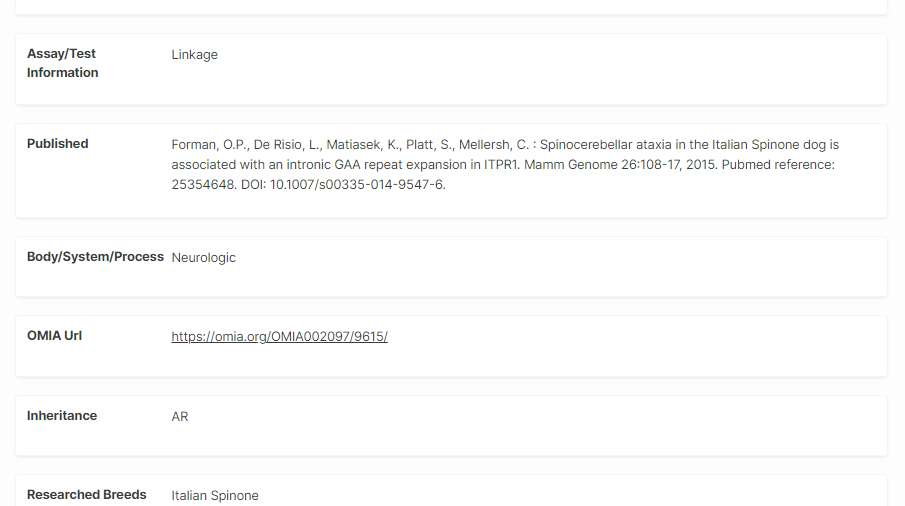This week in HGTD: direct variant/mutation, linkage, and risk tests – what are they?
This blog describes common types of individual disease/trait genetic tests. Understanding the principles behind these tests can improve confidence in applying test results to breeding strategies and other decision-making, in conjunction with health experts.
The development of direct to consumer genetic testing means that many veterinarians, canine health advisors, breed and kennel clubs, and individual owners are basing breeding and other health considerations on testing information that isn't always clear or easy to interpret. It can also be confusing to distinguish between how the test is performed versus how the test results might be applied. One aspect of genetic testing that can be difficult is confidence in the precision of the genetic testing being used. Owner decisions based on genetic test results directly impacts the individual dog as well as breeding strategies, especially if the variant being tested for indicates a significant risk of developing a disease.
Direct variant testing
Currently the majority of genetic tests developed are based on research where a specific variant (e.g. mutation) is identified that is causal for a disease or trait. This provides a high amount of confidence and precision – e.g. if your dog tests for 2 copies of the causal mutation, the dog is genetically affected and is likely to develop the disease/trait/phenotype, and can pass on 1 copy of the variant to any offspring. Owners can use simple breeding strategies based on the different modes of autosomal inheritance (e.g. autosomal recessive, autosomal dominant) to precisely eliminate the risks of having affected offspring while still including the majority of dogs in the breeding population to conserve or improve genetic diversity. An example of this test type is for CLAD in Irish Red Setters. Kennel Club breeders of registered Irish Red Setters in the UK (and elsewhere) used the genetic test for this variant to essentially remove the variant within the pedigree breed in the UK, meaning that the UK population of Kennel Club registered Irish Red Setters do not have the variant within the population.
Linkage testing
DNA sequences that are close together on a chromosome tend to be inherited together, so tests can use genetic variation surrounding a specific variant – the “link” - to infer the presence or absence of a variant that is associated with a disease/trait. Linkage tests may be used where the variant is known (or statistically likely) but technically challenging to detect or where the variant is known, but may be protected by a patent, unpublished/proprietary. Linkage assays (how the test is performed) are often nearly as precise as a direct variant assay, but by their nature carry a higher risk of misleading results. A laboratory should be estimating accuracy and have that information available. . An example is Spinocerebellar Ataxia (CA) in the Italian Spinone. In this case, the mutation associated with this disease is technically very challenging to assay directly, so markers have been identified that are linked to the mutation and inherited together. It is generally felt that when a specific variant/mutation is known, it is preferable, and less risk of errors, to use an assay testing for that variant
... and then there's “Risk” testing
A "Risk" test describes a type of test, but not how the test is performed. The assay may be either a direct variant or linkage test. In some cases, specific mutations or regions in the genome can indicate a strong association with a disease/trait, but are not determined to be completely causal. It could be that there is complex inheritance, more than one variant involved, or other factors that determine the phenotype in the dog. However, by having these specific mutations or regions, the dog is statistically at risk for a disease/trait. For these tests, it would be expected for the risks to be estimated and reported, e.g. “dogs who have these mutations are 60% more likely to develop this disease than dogs who do not.” They also often have very specific guidance for interpreting and applying test results. While risk tests can be helpful when used appropriately to reduce disease risk in a population, be aware that misuse of the test can not only result in marginal or no gains in reducing disease, but also the reduction of genetic diversity potentially causing other health issues in a breed. An example of a risk test is for Dermatomyositis which tests for combinations of risk alleles in several collie breeds, or Degenerative Myelopathy, which varies by breed in how well the test predicts risk, and can vary by breed in what variants are required to estimate risk. Other terms for more complex inheritances include "multivariate" - where there is more than 1 known or unknown variant involved influencing phenotype, and modes of inheritance that include "incomplete penetrance" - meaning that there are a few dogs where the test results do not align with phenotype, but for the vast majority of dogs the test works well.
Where can I find the test type?
HGTD phenes information will comment where the assay is by direct variant/mutation and/or a linkage test. HGTD also provides inheritance information indicating an autosomal, risk or some other test type. This can be seen in the mode of inheritance (e.g. RV = Risk Variant) or in the new Assay/Test information (e.g. Linkage) There is also information provided, where possible, about the specific genes and mutation/variant(s) tested for. Each genetic test provider (GTP) is also requested to provide, or confirm, if the test is for the direct variant, linkage, or something else, under the GTP-specific information.
It is helpful to think about the different genetic tests on a scale of precision. If the test is based on the presence or absence of a specific variant that is known to be causal for a trait, then there is high precision in those test results, and they can be a good basis for decision making.
Bear in mind that none of the test types above can be assumed to be diagnostic. Diagnostic genetic tests in dogs are currently less common, have many more requirements of precision and accuracy, and are noted as diagnostic in the HGTD.
Take away:
- Understanding the precision, mode of inheritance, and application of a genetic test is key to robust decision making in breeding plans and in dog health care.
- HGTD provides information on what type of test(s) and assays are being offered by genetic test providers.
- Few genetic tests are diagnostic, and any health decision made should be based on veterinary advice, not a genetic test result alone.
- Veterinary health advisors should use extra caution when advising clients on the basis of genetic test results, especially for risk-based tests which may vary in precision of risk assessment.
- Even highly predictive genetic tests with genetically affected results do not guarantee that a dog will always develop clinical signs of a disease or trait. There can be other factors that determine the clinical effects of a disease.
 Donate
Donate

0 Comments
Recommended Comments
There are no comments to display.